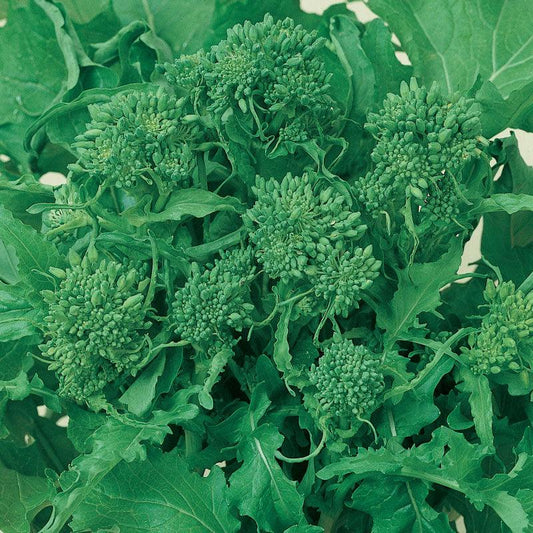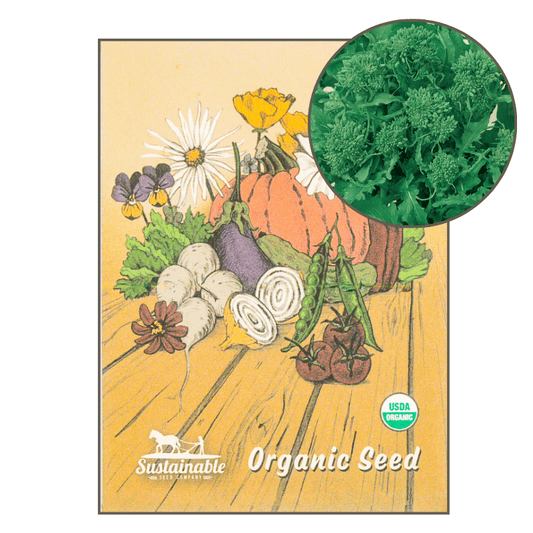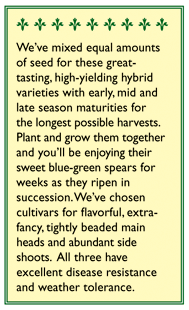Broccoli is a favorite cruciferous garden vegetable that thrives in cool weather. In most regions of the U.S., two broccoli crops can be grown, one in spring and one in fall, but the planting time will depend on the type of broccoli you grow.
If you're wondering when, exactly, is a good time to plant your broccoli seeds, enter your last frost date (for spring planting) and first frost date (for fall planting) into our Seed Planting Calculator. It will calculate the best dates to direct seed or start seeds indoors.
You can also calculate when to plant your seeds by using the sowing information on the back of the seed pack and counting backwards from your last frost date on your calendar.
Broccoli Types

Calabrese: A commonly marketed Italian variety with thick stems and dark green flower heads, both of which are eaten. Calabrese broccoli is considered a short-season variety. Produces one large main head with smaller side shoots.
Raab: Raab, rabe, or rapini broccoli, is a branching variety grown for its tops and tender flower shoots. This Italian heirloom produces no central head but an abundance of strap-leaves and side shoots. Raab broccoli looks like mustard with many dime-sized, green buds. This cool weather plant does not overwinter well in cold regions. Considered a short-season variety.
Romanesco: A hybrid of cauliflower with broccoli, it sends up small spirals that curve to form a large spiral head. Break it apart and eat it raw or steamed. Romanesco broccoli is prized for its delicate, nutty flavor as well as its vivid, light green color. May reach 3 feet before producing. Considered a long-season variety.
Purple: Very frost hardy (to below 10°F), bushy plant grows slowly through the winter, and in the spring plants are covered with small, very sweet tasting purple heads and many side shoots after growing over the winter. Plant purple broccoli in fall or spring. Considered a long-season variety.
Chinese: Fine stems, bright green color, flat green leaves, slightly bitter. Grown for its succulent stalks and flavor-rich leaves. Harvest the stalks when the buds are closed, or let a few open and have a flowering dish on your dinner table. Chinese broccoli is also called Chinese kale.
Growing Basics
Soil: Broccoli prefers a soil pH between 6 to 7 and temperatures of 60–65°F (will tolerate temperatures between 40–75°F). Try growing broccoli in some of our Peaceful Valley Organics Potting Soil; it is an excellent, organic all-around mix.
Seed Longevity: If properly stored, broccoli seeds should be viable for about 3 years.
Planting Depth: Plant broccoli seeds ¼” deep.
Spacing: Sow broccoli seeds 4–6” apart. Space the rows in your garden 18–36.” After your seeds have germinated thin so each broccoli plant is 12–24” apart.
Companion Planting:
- Incompatibility – cabbage, cauliflower, eggplant, beans, tomato, strawberry
- Companions – beets, spinach, chard, garlic, potatoes, cucumbers, rosemary
Water requirements: Best watered at soil level by drip irrigation or furrow watering. Deep water broccoli to avoid stunted plants and promote healthy plant growth.
Fertilization: Broccoli is a heavy feeder, especially after plants are larger (30
–50 days after transplanting). Consider light side dressings of nitrogen (feather meal or blood meal) every 4 weeks but taper off after heads start forming. Recommended planting a nitrogen-fixing cover crop (a Peaceful Valley Soil Builder Mix or the Nitro-Max Plow Down Mix) in beds where broccoli will be grown.
Weeding: Broccoli has a very shallow root system so hand weed carefully around plants. Use mulch to prevent weeds and to maintain even soil moisture.
Planting & Growing

For spring crops, it is best to plant from transplants and choose varieties that are short seasoned. For fall crops, seeds can be direct sown from July to August. Late summer planting is best for mild winter climates since the plants thrive in cool weather.
Spring Planting: Start seeds indoors 6–8 weeks before the last frost and transplant out to the garden about 2–3 weeks before your last spring frost. Mulch around plants to reduce weed growth and cover with a row cover such as Agribon AG15 to protect from insects.
Fall Crop: Direct sow broccoli seeds in the garden between July to August, or 85–100 days before the first fall frost. Long or short seasoned varieties can be planted. Late summer planting is best for mild winter climates since the plants thrive in cool weather and can over-winter. Purple sprouting broccoli is very winter hardy and is best planted in late summer to fall.
Keep plants well watered during growth and it is best to not allow plants to dry out between watering. Mulching will help retain moisture to the plants. Broccoli is a heavy feeder so feed with blood or feather meal according to the label.
Harvesting
Harvest broccoli when it is young; before it begins to split or bolt. Use a good harvest knife to cut the stem at an angle, leaving about 6” attached to the head. After harvesting the large central head (if that variety is grown), smaller side shoots will develop and can be harvested later (exception is the Romanesco, it will not develop side shoots).
Common Pests & Diseases

Aphids: usually found on the underside of leaves or on flower head. Control by strong spray of water (our Bug Blaster Spray Nozzle works great), beneficial insects, or organic insecticides labeled for aphids.
Lepidopteran: Diamondback moth, beet armyworm, cabbage looper, cabbage worm, tomato fruitworm. Control by hand picking, beneficial insects or organic insecticides labeled for lepidoptera.
Flea Beetle: Chews leaves and head. Control with sticky traps, barriers such as Agribon rowcover, or organic insecticides labeled for flea beetles.
Harlequin Bugs: Leaves have white spots and look tattered. Check on underside of leaves for eggs. Control with barriers such as Agribon rowcover, organic insecticides labeled for harlequin bugs or hand pick and destroy.
Swede Midge: Control with barriers such as Agribon rowcover, or organic insecticides labeled for swede midge.
Downy Mildew: Caused from poor air circulation and wet leaves. Do not water from above and keep leaves as dry as possible. Use an organic fungicide labeled for Downy mildew.
Pest Control – IPM (Integrated Pest Management)
Integrated Pest Management (IPM) is an effective and environmentally sensitive approach to pest management that starts with the least invasive or impactful control methods and considers the use of chemical controls as the last step. For more information watch our Integrated Pest Management video.
It is important to practice good cultural controls for pest management of broccoli. Cultural controls such as removing plants after harvest (to avoid leaving food for insects to continue to multiply on), use clean transplants, practice crop rotation (e.g. do not plant cole crops in same area for 3 years), use row covers such as Agribon AG15 (apply before insects have arrived).
Definitions
Heirloom: Heirloom seeds come from open-pollinated plants that pass on similar characteristics and traits from the parent plant to the next generation plant. Heirloom vegetables are old-time varieties generally which have been in production since before WWII, and have been saved and handed down through multiple generations.
Hybrid: a cross between two or more unrelated plant varieties. The two different varieties are cross bred, resulting in a seed that carries one or more favorable traits (increased yield, uniformity, color, disease resistance.) Hybrid seeds are not GMO, as they are manually cross-bred, not genetically modified in a lab. Hybrid seed is often sterile or does not reproduce true to the parent plant. Therefore, never save the seed from hybrids.
Open Pollinated: generally refers to seeds that will “breed true”. When the plants of an open-pollinated variety self-pollinate, or are pollinated by another representative of the same variety, the resulting seeds will produce plants roughly identical to their parents. Genetic traits may differ only slightly due to variations created by local conditions.
GMO: Genetically Modified Organisms were genetically modified in a laboratory where DNA genes are extracted and mixed with other unrelated plants to improve characteristics. Saved seed will not always be viable and may be trademarked to prevent unauthorized use.







